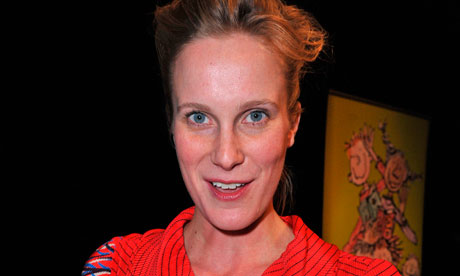
Friendship is not always easy – at Easter or at any time. And this season's crop of picture books takes on the question – so hard to answer, especially for little children – of how to make, and keep, friends. Frank & Teddy Make Friends by Louise Yates (Cape £10.99) is a winner of a book. We all know someone like Professor Frank Mouse. He is a clever loner, living in his head. He is introduced with the lightest of pencilled touches – with skinny pink legs and with a pair of binoculars round his neck. The style makes a change from the strident primary colours of many a picture book. Yates's beautifully written story describes the prof's solution: a DIY friend, a roughly stitched brown bear (he is seen victoriously wielding a needle on his creation's forehead). But friendship, as Yates shows, presents unforeseen challenges. A mess is made. Forgiveness is called for. A lovely, subtle book that makes its case ingeniously and will delight readers of every age.
Another common challenge in friendship is how to share. In Zoe and Beans: Where is Binky Boo? by Chloë and Mick Inkpen (Macmillan £10.99), Zoe faces this head-on when her dog, Beans, helps himself to her squashy rag doll, Molly, having lost his own chewable mascot, Binky Boo. He does everything but swallow Molly whole: "He licked and chewed and slobbered on her as if she was his very own…" Molly's experiences in the dog's mouth are described in comically convincing detail. This could not have been written by someone who was not a close student of dogs and children, and it is illustrated by Inkpen's daughter Chloë in a style as humorously assured as her dad's. (3 up)
In Bug and Bear: A Story of True Friendship by Ann Bonwill and Layn Marlow (OUP £10.99), one child wants to play, the other doesn't. This story confidently dramatises their conflict through the dramatis personae of a bug (it is in the nature of bugs to bug) and a siesta-seeking bear. The best moment is when the bear has a crisis of confidence after having told the bug to jump in a lake – reckless words the bug takes seriously. There is a sermon here – unpushily offered – about sometimes thinking about what your friends want and not always pleasing yourself. The reconciliation between friends is charmingly illustrated: the blue bug dozes happily on the bear's plump, primrose paunch. (2 up)
Chris Wormell can do no wrong: his books are beautifully conceived. In Scruffy Bear and the Six White Mice (Cape £10.99) he introduces us to a less snoozy bear. His is more dynamic, if unkempt, and in charge of six white mice. This is about the bear's attempts to save their lives. His actions are beyond the call of duty – his is a friendship that borders on heroism. There is a glorious illustration of the three predators: owl, fox and snake, with their indignant faces in close-up, realising, too late, that they have been duped. Children will follow the tale with excitement and relief. (3 up).
Wolf Won't Bite! by Emily Gravett (Macmillan £10.99) explores the cruel flip side of friendship. It is based on the idea that the three pigs have captured the wolf and turned him into a freakshow animal. The story is illustrated with verve. In one picture, the wolf wears a preposterous red bow around his scraggy grey neck. In another, he is being cut in half. In a third, the three pigs, in dinner dress, stick their frivolous heads into the wolf's jaw… Can you guess what happens next? Children will roar with pleasure at this rough justice (but don't worry, everyone survives). (4 up).
And should anyone feel that they – along with the wolf – have bitten off more than they can chew, Jeanne Willis's Mole's Sunrise, illustrated by Sarah Fox-Davies (Walker £11.99), makes a gentle antidote. At first, the book seems pleasantly inconsequential although invitingly illustrated (the mole's fur looks so soft you want to stroke it; the drawings are filled with the blueish light of dawn). The vole leads the mole to a branch from which to view the sunset with friends, all of whom energetically describe to him what they see. But it is only at the end of the story that the light of the narrative dawns and brings a tear to the eye: "Mole was blind but at last he'd seen the sunrise. He didn't see it with his eyes; he saw it in his mind. And it was even more beautiful than anyone could imagine." (3 up)

